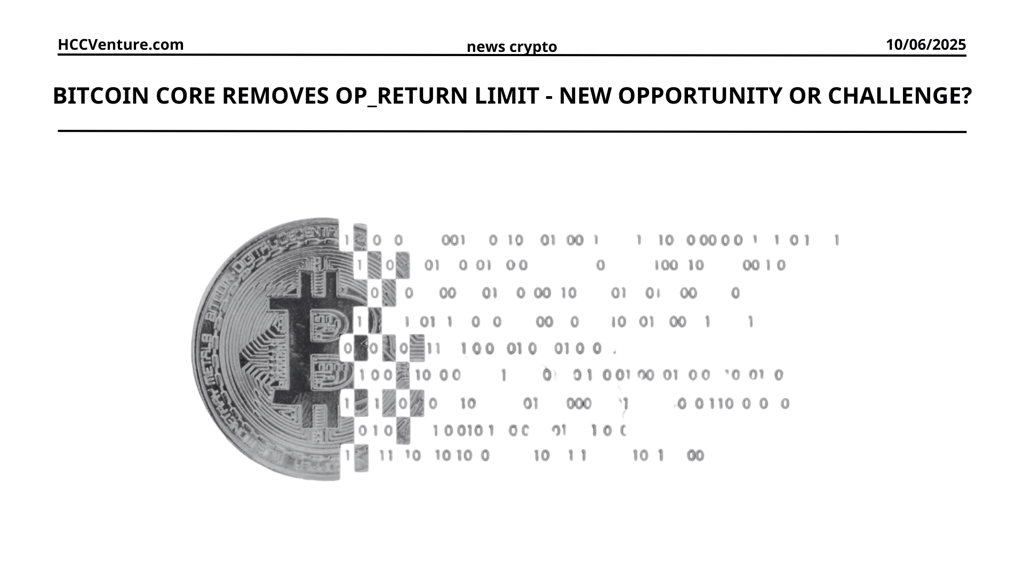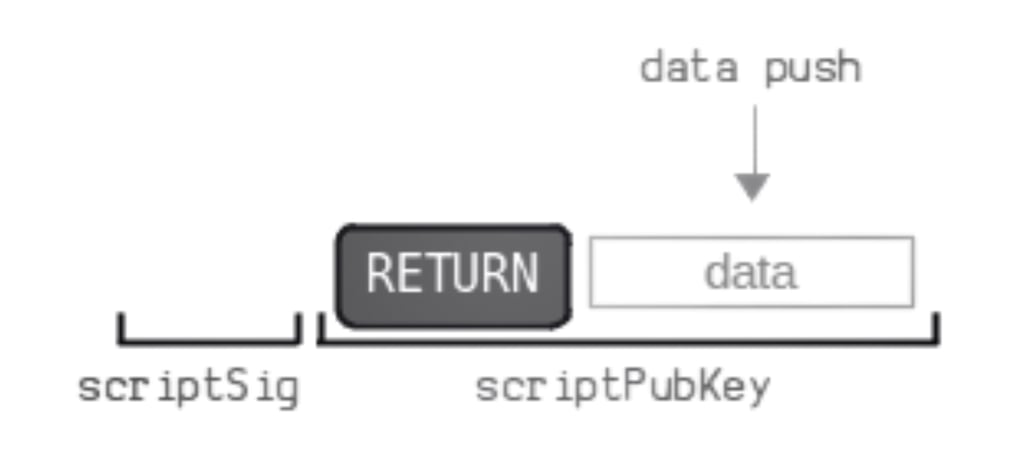Bitcoin Core Removes OP_RETURN Limit - Opportunity Or Challenge For Bitcoin Network?
An upcoming update to Bitcoin Core, the core software of the Bitcoin network, will reportedly remove the 80-byte limit on OP_RETURN, the mechanism that allows data to be written to the blockchain. The move has sparked heated debate in the cryptocurrency community about Bitcoin’s scalability potential and the potential impact on network performance.
6/10/20253 min read


Remove OP_RETURN restriction
OP_RETURN is a feature in the Bitcoin protocol that allows users to write small data (up to 80 bytes) to the blockchain without increasing the size of the unspent transaction set (UTXO). Introduced in 2014, OP_RETURN supports applications such as metadata storage, off-chain transaction validation, or integration with sidechains like Plasma, which issues Bitcoin-backed stablecoins.
The upcoming Bitcoin Core update will remove the 80-byte limit, allowing for larger data to be written, up to 4MB in some cases. The proposal is intended to meet the growing needs of applications such as Bitcoin Stamps, NFTs, and the SRC-20 token protocol, which require more complex data storage. However, the move also raises concerns about the possibility of “spam” on the blockchain, increasing block sizes and node operating costs.
The need to expand Bitcoin's functionality
Bitcoin was originally designed as a decentralized currency with a focus on security and efficiency in financial transactions. However, the growth of applications such as Ordinals, Bitcoin Stamps, and SRC-20 has driven demand for the Bitcoin blockchain to store non-financial data, such as NFTs or metadata for smart contracts. The 80-byte limit of OP_RETURN has led developers to resort to workarounds such as forging public keys or splitting data, which increases UTXO sizes and puts pressure on the network.
The event comes amid a vibrant cryptocurrency market. For example, Plasma – a Bitcoin sidechain that issues stablecoins – just raised $500 million in its XPL token sale on June 9, 2025, demonstrating the potential for applications that integrate with Bitcoin. The OP_RETURN update is expected to better support such projects, but it also raises questions about how Bitcoin balances efficiency and innovation.


Removing the OP_RETURN limit will bring many opportunities to the Bitcoin network:
Protocols like SRC-20 and Bitcoin Stamps can store images, text, or more complex metadata, helping Bitcoin compete with blockchains like Ethereum in the NFT and DeFi space.
Projects like Plasma, which use Bitcoin as a settlement layer for stablecoins, will easily record metadata, thereby improving transaction efficiency and integrating with sidechains.
The OP_RETURN extension can support off-chain transaction confirmation, cross-border payments, or Layer 2 solutions like the Lightning Network.
For example, Plasma's $500 million raise shows strong demand for stablecoin applications on Bitcoin, and unlimited OP_RETURN will be a big boost for similar projects.
Despite the benefits, this update also poses challenges:
Larger data from OP_RETURN transactions can increase block sizes, leading to higher transaction fees and longer processing times, especially during periods of network congestion.
Larger blockchains will require more storage and processing resources, which could reduce the number of full nodes, affecting the decentralization of Bitcoin.
Removing the limit may lead to “spam” transactions, such as storing unnecessary data (ads, irrelevant content), reducing network efficiency.
Bitcoin Core developers argue that standardizing OP_RETURN will help reduce more harmful methods of circumvention, such as public key forgery. However, without strict controls, the Bitcoin network could face similar pressures as during the “Ordinals craze” of 2023.
Evaluation and Conclusion
This opens the door for new applications like NFTs, stablecoins, and DeFi on the Bitcoin blockchain. However, it also poses challenges in terms of network performance and decentralization, which require careful balancing by the community. With projects like Plasma gaining traction, this could be the moment for Bitcoin to assert its role beyond “digital gold.”
Investors and developers should closely monitor the impact of this update, as it could shape the future of Bitcoin in the cryptocurrency ecosystem. Stay tuned to stay updated on the latest developments!
Once again we give our opinion on potential projects in the crypto market. This is not investment advice, consider your portfolio. Disclaimer: The views expressed in this article are solely those of the author and do not represent the platform in any way. This article is not intended to be a guide to making investment decisions.
Compiled and analyzed by HCCVenture
Join HCCVenture here: https://linktr.ee/holdcoincventure
Explore HCCVenture group
HCCVenture © 2023. All rights reserved.


Connect with us
Popular content
Contact to us
E-mail : holdcoincventure_contact@hccventure.com
Register : https://linktr.ee/holdcoincventure
Disclaimer: The information on this website is for informational purposes only and should not be considered investment advice. We are not responsible for any risks or losses arising from investment decisions based on the content here.


TERMS AND CONDITIONS • CUSTOMER PROTECTION POLICY
ANALYTICAL AND NEWS CONTENT IS COMPILED AND PROVIDED BY EXPERTS IN THE FIELD OF DIGITAL FINANCE AND BLOCKCHAIN BELONGING TO HCCVENTURE ORGANIZATION, INCLUDING OWNERSHIP OF THE CONTENT.
RESPONSIBLE FOR MANAGING ALL CONTENT AND ANALYSIS: HCCVENTURE FOUNDER - TRUONG MINH HUY
Read warnings about scams and phishing emails — REPORT A PROBLEM WITH OUR SITE.
